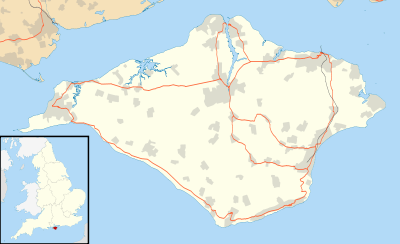Binstead
| Binstead | |
|---|---|
 Binstead Binstead shown within the Isle of Wight | |
| Population | 3,185 (2011 Census)[1] |
| OS grid reference | SZ573922 |
| Unitary authority | |
| Ceremonial county | |
| Region | |
| Country | England |
| Sovereign state | United Kingdom |
| Post town | RYDE |
| Postcode district | PO33 |
| Dialling code | 01983 |
| Police | Hampshire |
| Fire | Isle of Wight |
| Ambulance | Isle of Wight |
| EU Parliament | South East England |
| UK Parliament | |
Binstead is a village on the Isle of Wight. It is located in the northeast of the Island, two kilometres west of Ryde on the main road (A3054) between Ryde and Newport. By the time of the 2011 Census Binstead had been incorporated within Ryde whilst still retaining its electoral ward called Binsted and Fishbourne.
Amenities
The village has a post office/general store as its sole remaining shop. Until the end of February 2009, when it was finally removed, it had a modern style BT phone box outside. There was also a second shop located opposite the Post Office until sometime in the 2000s. It is now a residential dwelling.
Binstead has a primary school,[2], 2 recreational fields and has access to a public common (Dame Anthony's Common) and beach (Player's Beach).
Brickfields, a small horse riding centre, was located off Newnham Road to the South of Binstead. It closed for good in 2013.
The local pub is "The Fleming Arms", located on Binstead Road.
Southern Vectis bus route 9 serves the main road every 10 minutes in the daytime between Ryde and Newport.[3] Route 4 links the town with East Cowes and local route 37 covers other areas linking to Ryde.[4]
History
Binstead is recorded in 1086 in the Domesday Book as Benestede.[5] It became known for the quality of its limestone which led to a local quarrying industry, the result of which is still visible in the village’s landscape and place names. The nearby Quarr Abbey takes its name from ‘quarry’ and the suffix ‘pitts’ is occasionally found in house and road names. The quarries were known as pits.
The earliest recorded quarrying was by the first Norman Bishop of Winchester, Walkelin, who was granted half a hide of land by William the Conqueror. He used the stone to construct Winchester Cathedral starting in 1079. Subsequently, the stone was used in the building of Chichester Cathedral, Romsey Abbey and part of the Tower of London.
During the Napoleonic War Daniel List, a local shipwright, successfully carried out shipbuilding at Binstead for the Royal Navy, comprising three 36-gun frigates - HMS Magicienne in 1812, and HMS Tagus and HMS Tiber in 1813.
Churches
Binstead has two churches (the Methodist and the Holy Cross) and a monastery (Quarr Abbey) is located nearby.
Church of the Holy Cross
References
- ↑ "Civil Parish population 2011". Neighbourhood Statistics. Office for National Statistics. Retrieved 1 February 2017.
- ↑ http://www.binsteadpri.iow.sch.uk Binstead Primary School
- ↑ "Southern Vectis - bus route 9". www.islandbuses.info. 2008. Archived from the original on 2008-06-07. Retrieved 2008-05-04.
- ↑ "Southern Vectis bus routes". Southern Vectis. Archived from the original on 2009-11-30. Retrieved 2010-04-17.
- ↑ Domesday Book http://www.nationalarchives.gov.uk/domesday/
External links
![]()